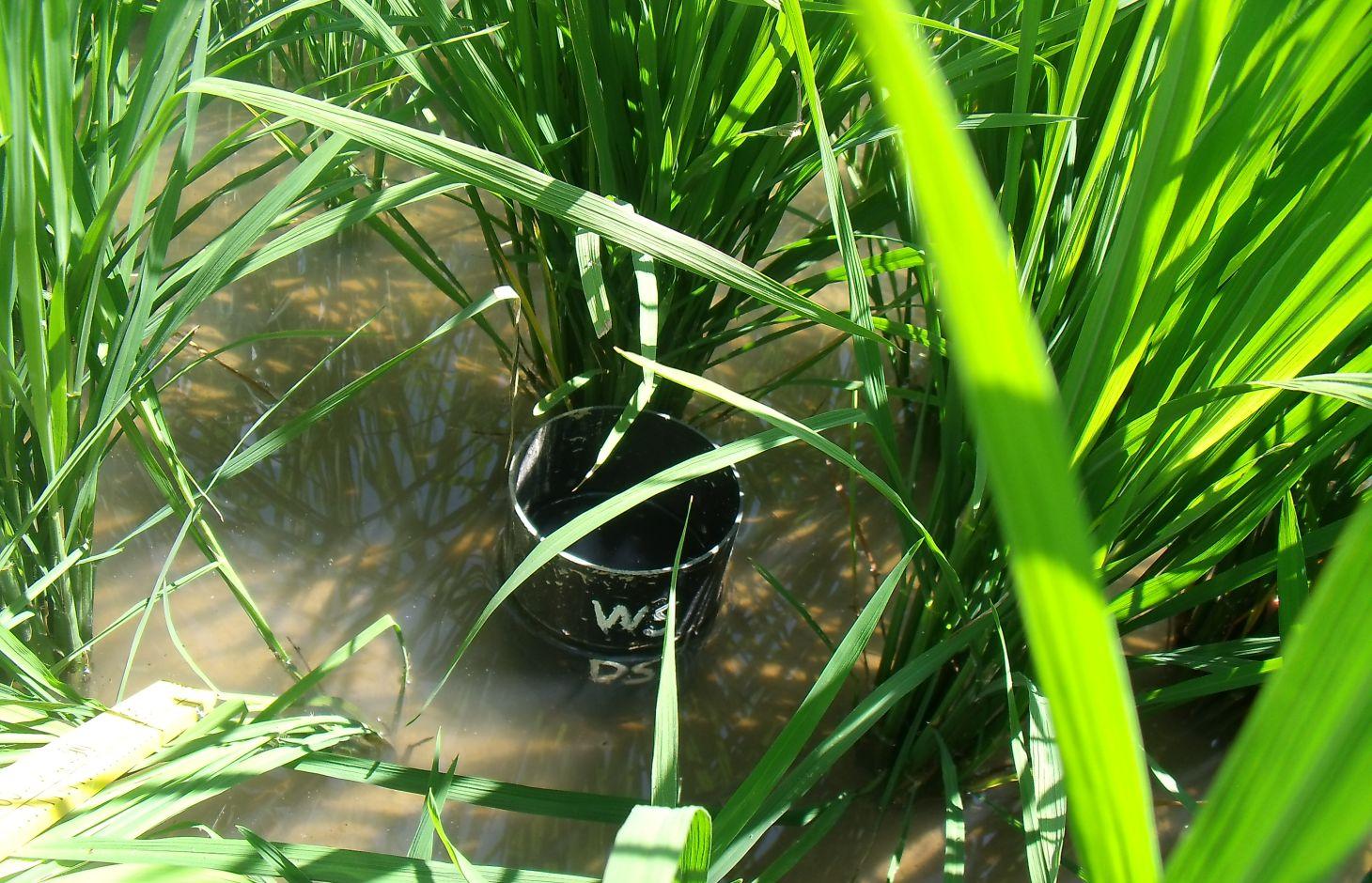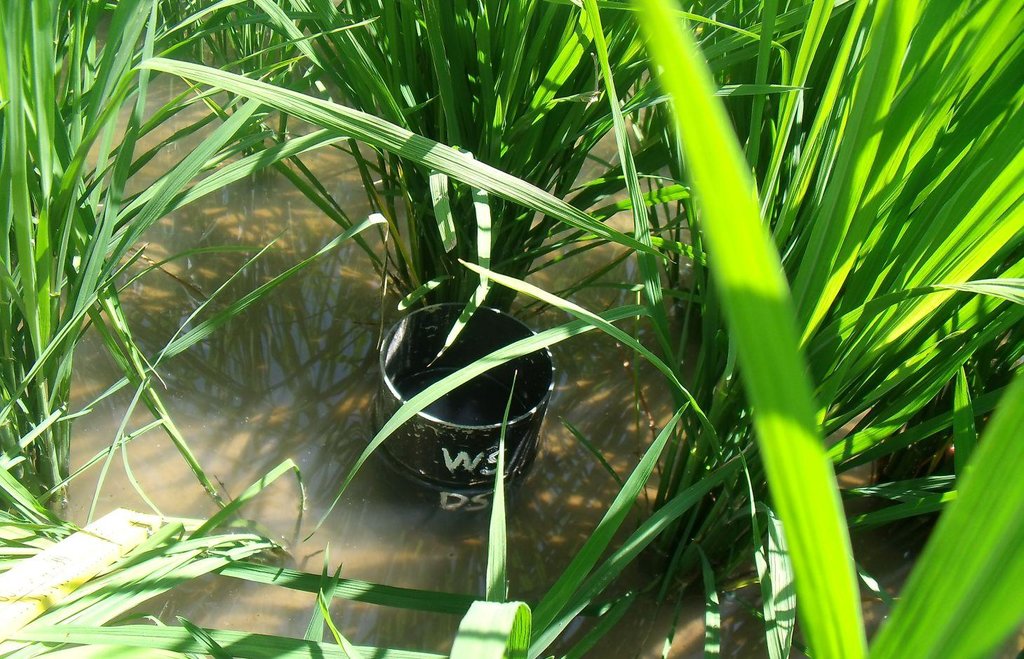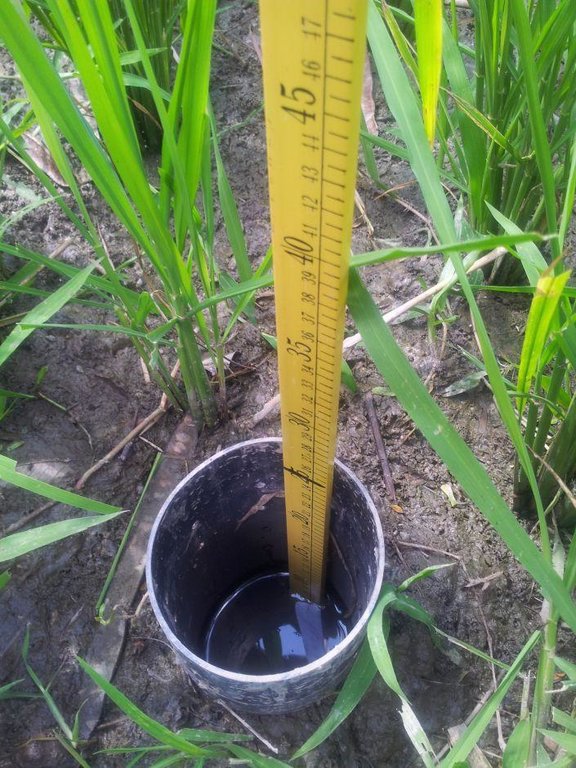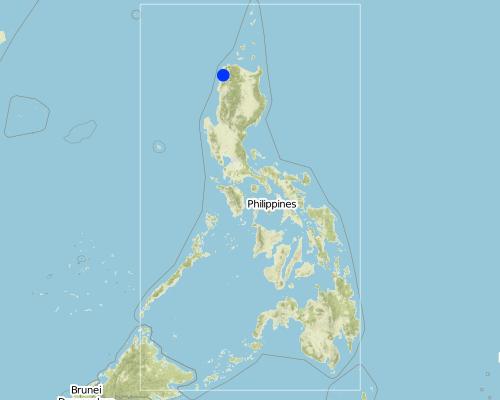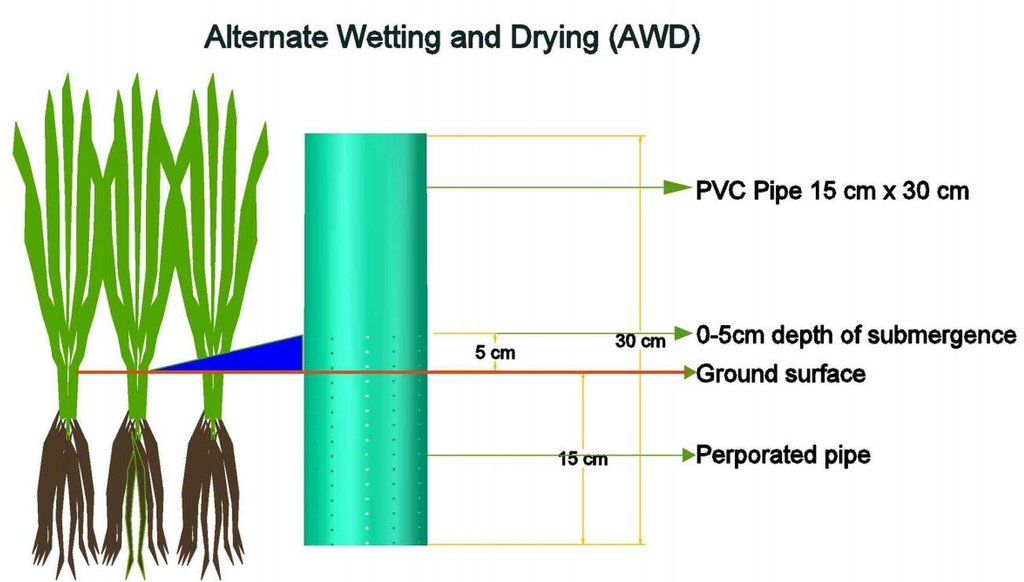Alternate Wetting and Drying [Philippines]
- Creation:
- Update:
- Compiler: Philippine Overview of Conservation Approaches and Technologies
- Editor: –
- Reviewer: David Streiff
technologies_1725 - Philippines
View sections
Expand all Collapse all1. General information
1.2 Contact details of resource persons and institutions involved in the assessment and documentation of the Technology
Key resource person(s)
SLM specialist:
Dinamling Djolly Ma
DA-BSWM
Philippines
SLM specialist:
Raquid Jemar G.
DA-BSWM
Philippines
SLM specialist:
Martinez Mamerto F.
DA-BSWM
SLM specialist:
Pascual Kristine
Philrice
Philippines
SLM specialist:
Sibayan Evangeline B.
Philrice
Philippines
Name of the institution(s) which facilitated the documentation/ evaluation of the Technology (if relevant)
Bureau of Soils and Water Management (Bureau of Soils and Water Management) - PhilippinesName of the institution(s) which facilitated the documentation/ evaluation of the Technology (if relevant)
Philippine Rice Research Institute (PhilRice) - Philippines1.3 Conditions regarding the use of data documented through WOCAT
When were the data compiled (in the field)?
11/02/2016
The compiler and key resource person(s) accept the conditions regarding the use of data documented through WOCAT:
Ja
1.5 Reference to Questionnaire(s) on SLM Approaches

Palayamanan: Climate Change Adaptation Strategy for Lowland Ecosystem [Philippines]
Synergistic mix of farming ventures implemented by the farm family based on the existing environment and their resources to address food security, income instability, and sustainability.
- Compiler: Philippine Overview of Conservation Approaches and Technologies
2. Description of the SLM Technology
2.1 Short description of the Technology
Definition of the Technology:
Alternate Wetting and Drying is a water-use management technique wherein irrigation water input could be substantially reduced to as much as 35% without significantly affecting rice yields.
2.2 Detailed description of the Technology
Description:
It was observed that most of the farmer’s irrigation practice of continuously flooding their rice fields is wasteful and uneconomical. The imbalance amount of water, either in deficit or excess, might affect the development and productivity of the crops.
With this inefficient water use and coupled by the increasing frequency of drought, vulnerability to water scarcity is inevitable. Furthermore, it has been recognized that poor water management practices contributed to the process of land degradation. Hence, there is a need to practice proper water management in rice cultivation. As an integral part of the Palayamanan system, the Philippine Rice Research Institute (PhilRice) introduced a water saving technology to the farmers called Alternate Wetting and Drying (AWD).
The AWD modifies the irrigation scheduling and application and eventually the amount of water to be use in the field. Irrigation water is applied a few days after the disappearance of the ponded water in the so-called “observation well”. Hence, the field is alternately flooded and non-flooded.
Purpose of the Technology: The following are the purpose of this technology: (1)reducing water use for irrigation so that it can be used for other purposes, (2) reducing the use of irrigation water because there is less of it, and (3) reducing the use of irrigation water to reduce the cost. Emission of greenhouse gas (GHG) specifically on methane is reduced since this is caused by flooding of ricefields.
Establishment / maintenance activities and inputs: Practical implementation of AWD is facilitated using a simple tool called a 'field water tube' as observation well, used in monitoring the water level in the field.It is made of a 25 cm long PVC pipe with a diameter of 10 to 15 cm. In some instances, bamboo can be used instead of the PVC pipe. The pipe is perforated with many holes on all sides to allow lateral movement of water in the root zone. It is installed into the soil by ensuring that 10 (dry season) or 5 (wet season) cm protrudes above the soil surface. Soil must be removed inside the tube so that the bottom is visible. During the first 21 to 30 days after direct seeding or transplanting, 2 to 3 cm of water is maintained to control weeds and to ensure that the crop has already
recovered from transplanting shock. AWD is imposed after 21 to 30 days where the water in the tube is monitored. Once the water inside the tube disappears, irrigation is applied to a water depth of 5 cm above soil surface. It is noted that during fertilizer application and flowering stage, sufficient water is maintained to avoid spikelet sterility. Terminal drainage from one to two weeks before the expected time of harvest is also done to promote uniform maturity of the crop and to facilitate easement of post-harvest operations in the field.
Natural / human environment: The area is under a humid climate experiencing wet and dry season with an annual average rainfall ranging from 1000-1500 mm per year. The technology was applied to irrigated rice field in flat and plain areas.
2.3 Photos of the Technology
2.5 Country/ region/ locations where the Technology has been applied and which are covered by this assessment
Country:
Philippines
Region/ State/ Province:
San Nicolas, Dingras
Further specification of location:
Ilocos Norte
Map
×2.6 Date of implementation
If precise year is not known, indicate approximate date:
- 10-50 years ago
2.7 Introduction of the Technology
Specify how the Technology was introduced:
- through projects/ external interventions
3. Classification of the SLM Technology
3.2 Current land use type(s) where the Technology is applied

Cropland
- Annual cropping
Main crops (cash and food crops):
major cash crop: rice
major food crop: rice
Comments:
Major land use problems (compiler’s opinion): lack of irrigation water
3.3 Further information about land use
other (e.g. post-flooding):
- controlled flooding
Comments:
The field is alternately flooded and non-flooded.
Number of growing seasons per year:
- 2
3.4 SLM group to which the Technology belongs
- irrigation management (incl. water supply, drainage)
3.5 Spread of the Technology
Specify the spread of the Technology:
- evenly spread over an area
If the Technology is evenly spread over an area, indicate approximate area covered:
- < 0.1 km2 (10 ha)
Comments:
This is practiced in most of the "Palayamanan" sites in Ilocos Norte.
3.6 SLM measures comprising the Technology

management measures
- M4: Major change in timing of activities
- M7: Others
Comments:
Main measures: management measures
Specification of other management measures: water use management
3.7 Main types of land degradation addressed by the Technology

water degradation
- Hs: change in quantity of surface water
Comments:
Main type of degradation addressed: Hs: change in quantity of surface water
Main causes of degradation: crop management (annual, perennial, tree/shrub), other human induced causes (specify) (water use management)
3.8 Prevention, reduction, or restoration of land degradation
Specify the goal of the Technology with regard to land degradation:
- prevent land degradation
Comments:
Main goals: prevention of land degradation
4. Technical specifications, implementation activities, inputs, and costs
4.1 Technical drawing of the Technology
4.2 Technical specifications/ explanations of technical drawing
PVC pipe used for the technology.
Location: Ilocos Norte
Technical knowledge required for field staff / advisors: moderate
Technical knowledge required for land users: moderate
Main technical functions: more efficient water use
Major change in timing of activities: AWD modifies the irrigation scheduling and application
Other type of management: Water use management on irrigation water is applied a few days after the disappearance of ponded water in the field water tube.
4.3 General information regarding the calculation of inputs and costs
Specify currency used for cost calculations:
- US Dollars
Indicate average wage cost of hired labour per day:
3.33
4.4 Establishment activities
| Activity | Type of measure | Timing | |
|---|---|---|---|
| 1. | Preparation of the PVC/bamboo pipes | Management | |
| 2. | Perforation with many holes on all sides of the PVC/bamboo pipe | Management |
4.5 Costs and inputs needed for establishment
| Specify input | Unit | Quantity | Costs per Unit | Total costs per input | % of costs borne by land users | |
|---|---|---|---|---|---|---|
| Labour | Perforation with many holes on all sides of the PVC/bamboo pipe | Person/day | 1.0 | 3.33 | 3.33 | 100.0 |
| Construction material | Preparation of the PVC/bamboo pipes | piece | 1.0 | 4.44 | 4.44 | |
| Total costs for establishment of the Technology | 7.77 | |||||
4.6 Maintenance/ recurrent activities
| Activity | Type of measure | Timing/ frequency | |
|---|---|---|---|
| 1. | Installation of the PVC/bamboo pipe into the soil | Management |
5. Natural and human environment
5.1 Climate
Annual rainfall
- < 250 mm
- 251-500 mm
- 501-750 mm
- 751-1,000 mm
- 1,001-1,500 mm
- 1,501-2,000 mm
- 2,001-3,000 mm
- 3,001-4,000 mm
- > 4,000 mm
Agro-climatic zone
- humid
Thermal climate class: tropics
5.2 Topography
Slopes on average:
- flat (0-2%)
- gentle (3-5%)
- moderate (6-10%)
- rolling (11-15%)
- hilly (16-30%)
- steep (31-60%)
- very steep (>60%)
Landforms:
- plateau/plains
- ridges
- mountain slopes
- hill slopes
- footslopes
- valley floors
Altitudinal zone:
- 0-100 m a.s.l.
- 101-500 m a.s.l.
- 501-1,000 m a.s.l.
- 1,001-1,500 m a.s.l.
- 1,501-2,000 m a.s.l.
- 2,001-2,500 m a.s.l.
- 2,501-3,000 m a.s.l.
- 3,001-4,000 m a.s.l.
- > 4,000 m a.s.l.
Indicate if the Technology is specifically applied in:
- not relevant
5.3 Soils
Soil depth on average:
- very shallow (0-20 cm)
- shallow (21-50 cm)
- moderately deep (51-80 cm)
- deep (81-120 cm)
- very deep (> 120 cm)
Soil texture (topsoil):
- medium (loamy, silty)
5.4 Water availability and quality
Availability of surface water:
good
Water quality (untreated):
good drinking water
5.5 Biodiversity
Species diversity:
- medium
5.6 Characteristics of land users applying the Technology
Market orientation of production system:
- mixed (subsistence/ commercial
Off-farm income:
- less than 10% of all income
Relative level of wealth:
- average
Individuals or groups:
- groups/ community
Level of mechanization:
- manual work
- animal traction
Gender:
- men
Indicate other relevant characteristics of the land users:
Land users applying the Technology are mainly common / average land users
Population density: 10-50 persons/km2
Market orientation: Rice produced are intended for market and food consumption for the family
Annual population growth: 1% - 2%; 1%
5.7 Average area of land owned or leased by land users applying the Technology
- < 0.5 ha
- 0.5-1 ha
- 1-2 ha
- 2-5 ha
- 5-15 ha
- 15-50 ha
- 50-100 ha
- 100-500 ha
- 500-1,000 ha
- 1,000-10,000 ha
- > 10,000 ha
Is this considered small-, medium- or large-scale (referring to local context)?
- small-scale
Comments:
Average area of land owned or leased by land users applying the Technology: < 0.5 ha, 0.5-1 ha and1-2 ha
5.8 Land ownership, land use rights, and water use rights
Land ownership:
- individual, titled
Land use rights:
- leased
- individual
Water use rights:
- communal (organized)
5.9 Access to services and infrastructure
health:
- poor
- moderate
- good
education:
- poor
- moderate
- good
technical assistance:
- poor
- moderate
- good
employment (e.g. off-farm):
- poor
- moderate
- good
markets:
- poor
- moderate
- good
roads and transport:
- poor
- moderate
- good
financial services:
- poor
- moderate
- good
6. Impacts and concluding statements
6.1 On-site impacts the Technology has shown
Socio-economic impacts
Water availability and quality
demand for irrigation water
Other socio-economic impacts
weed growth during dry period
Comments/ specify:
seen as disadvantage
Socio-cultural impacts
conflict mitigation
Ecological impacts
Water cycle/ runoff
surface runoff
excess water drainage
evaporation
6.3 Exposure and sensitivity of the Technology to gradual climate change and climate-related extremes/ disasters (as perceived by land users)
Climate-related extremes (disasters)
Climatological disasters
| How does the Technology cope with it? | |
|---|---|
| drought | well |
Hydrological disasters
| How does the Technology cope with it? | |
|---|---|
| general (river) flood | well |
6.4 Cost-benefit analysis
How do the benefits compare with the establishment costs (from land users’ perspective)?
Short-term returns:
positive
Long-term returns:
positive
How do the benefits compare with the maintenance/ recurrent costs (from land users' perspective)?
Short-term returns:
positive
Long-term returns:
positive
6.5 Adoption of the Technology
Comments:
Comments on acceptance with external material support: No exact data is available to determine the numbers of land user who adopted the technology but most of the "Palayamanan" farmer partners in the irrigated areas adopted and practiced it.
Comments on spontaneous adoption: No exact data is available to determine the numbers of land user who adopted the technology but most of the "Palayamanan" farmer partners in the irrigated areas adopted and practiced it.
There is a moderate trend towards spontaneous adoption of the Technology
Comments on adoption trend: Most of the land users practicing "Palayamanan" in the municipality and province of Ilocos Norte is adopting the technology.
6.7 Strengths/ advantages/ opportunities of the Technology
| Strengths/ advantages/ opportunities in the land user’s view |
|---|
| Positive outcome primarily in water savings without significant yield difference from the usual practice. |
| Strengths/ advantages/ opportunities in the compiler’s or other key resource person’s view |
|---|
| Simplicity of the technology's method. |
| AWD leads to firmer soil conditions at harvest, which is beneficial to operating machines in the field. |
6.8 Weaknesses/ disadvantages/ risks of the Technology and ways of overcoming them
| Weaknesses/ disadvantages/ risks in the land user’s view | How can they be overcome? |
|---|---|
| Prone to weed growth during the period when the soil is dry. | Proper weed management |
Links and modules
Expand all Collapse allLinks

Palayamanan: Climate Change Adaptation Strategy for Lowland Ecosystem [Philippines]
Synergistic mix of farming ventures implemented by the farm family based on the existing environment and their resources to address food security, income instability, and sustainability.
- Compiler: Philippine Overview of Conservation Approaches and Technologies
Modules
No modules


